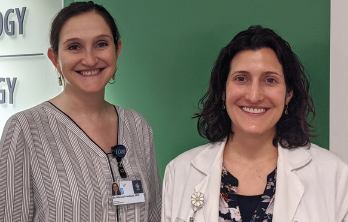
Dr. Friedman (left) & Dr. Desmarais
We have all been there when a patient with a systemic autoimmune disease needs sudden coordination of care. Your patient with Behçet’s disease nonchalantly mentions he hasn’t been able to see out of his right eye for two days. The spouse of one of your patients with sarcoidosis writes to you on the patient portal to tell you that your patient can’t move his right arm or right leg very well. Your scleroderma patient with known lung disease is suddenly short of breath. These patients have a talent for coming in on Friday afternoon and not realizing how serious the problem is, and you are left to troubleshoot with any colleague still answering their pager.
Multidisciplinary clinics grew out of the need to address these complicated patients. At best, multidisciplinary clinics provide streamlined expert care from providers who respect each other and work collaboratively. At worst, one provider pontificates over another specialist who may be younger or at an earlier stage in their career. But how do we get there, and how do we get it right?
The Oregon Health & Science University (OHSU) Experience
What exactly makes a multidisciplinary clinic? Shared space, shared appointments or just a shared cohort of patients about whom communication is a regular part of care? We present here our experience with multidisciplinary rheumatology clinics currently operating at OHSU, Portland.
Some clinics share space, and others are physically separated, but coordinate closely. What all of these clinics have in common is a core group of physicians with an interest in rheumatic diseases, expertise in the care for these patients and, most important, an enthusiasm for collaborating with other specialists.
In our opinion, when set up and operated correctly, multidisciplinary clinics are extraordinarily beneficial for patients, exciting and intellectually gratifying experiences for clinicians and should be the standard of care in academic rheumatology departments.
Rheumatology & Dermatology
The Center for Excellence in Psoriasis & Psoriatic Arthritis & the Rheumatology–Dermatology Clinic
Rheumatology and dermatology are natural areas for collaboration, because rheumatic disease patients often have dermatologic manifestations and vice versa. The Center for Excellence in Psoriasis and Psoriatic Arthritis consists of one rheumatologist and one dermatologist. These providers practice in separate spaces, but closely coordinate their clinical findings and expert opinions.
The Rheumatology–Dermatology Clinic, on the other hand, operates in a shared clinic space and time, one half-day each week. This clinic consists of two dermatologists with expertise in systemic inflammatory disorders and two rheumatologists with respective expertise in lupus, scleroderma and vasculitis, as well as learners at all levels.
Patients who need to see both dermatologists and rheumatologists—for example, a patient with active cutaneous and systemic lupus—will be scheduled for two appointments. For the most part, however, the four providers in this clinic see separate patients and consult with each other when necessary in a shared workroom. Common examples include a rheumatology patient with palpable purpura who needs a biopsy, or a dermatology patient who has cutaneous lupus and needs to be evaluated for systemic involvement.
OHSU Center for Interstitial Lung Disease
This clinic is a collaboration among three pulmonologists and two rheumatologists in a shared space. The schedules are coordinated so that in one day the patient will have studies done, such as pulmonary function testing, and see each specialty in separate appointments in the same clinic space. Rheumatologists and pulmonologists share the same workroom for discussing patient care decisions and easier coordination.
OHSU Vasculitis Center
The OHSU Vasculitis Center includes specialists from rheumatology, dermatology, nephrology, pulmonology, ophthalmology and otolaryngology. With the exception of dermatology, these providers do not share clinic space or time. Each member has experience, interest and expertise in treating patients with vasculitis. In fact, many of these patients are first recognized as having vasculitis in clinics outside rheumatology.
Here, the rheumatologist is usually at the center of patient care and coordinates with all other specialists, although in some cases the primary disease manifestation is localized to one organ system, and in such cases that provider leads in management.
The rheumatologist coordinating a patient’s care relies on the assessments and findings of other specialists. For example, patients with granulomatosis with polyangiitis and subglottic stenosis see an otolaryngologist early in the morning when they undergo laryngoscopy, and then come to the rheumatology clinic where the results of the laryngoscopy guide care decisions.
OHSU Myositis Clinic
This clinic consists of one rheumatologist and one neurologist, and takes place in a shared space once monthly. Each patient has one appointment in which a rheumatologist and a neurologist see the patient together in the same clinic room. The neurologist performs a detailed neurologic exam, and the rheumatologist evaluates for extramuscular disease. Having the perspective of both fields allows these providers to formulate a comprehensive treatment plan.
Rheumatology–Ophthalmology Clinic
The inflammatory eye disease clinic specializes in uveitis, scleritis, dry eyes, orbitopathies and other inflammatory eye diseases. This clinic takes place in a shared place and time, and consists of one rheumatologist with unique expertise in inflammatory eye disease, ophthalmologists, a uveitis fellow and other trainees.
Advantages of a Multidisciplinary Clinic
Convenience for patients traveling from a long distance: OHSU is located in a major metropolitan area, but much of the surrounding region has limited or no access to specialty care. Patients from Oregon, Idaho, southern Washington and even Alaska travel to the university for their specialty care. For such patients, it is a tremendous advantage to see numerous specialists during the same visit and be able to leave with a comprehensive plan of care. Many rural areas lack access to a rheumatologist or pulmonologist;
however, at our Center for Interstitial Lung Disease, a patient with rheumatic disease-
associated interstitial lung disease, for example, can make one trip, be seen by both specialists, undergo a full workup and leave with a coordinated care plan.
Provision of urgent/emergent care: Rheumatic emergencies can be difficult to diagnose and understand for the untrained eye. In one of the cases presented above, we mentioned a patient with a history of neuro-
Behçet’s disease who presented for a routine Friday afternoon clinic visit reporting newly reduced vision in one eye. The rapid availability and coordination with ophthalmologists who have expertise in inflammatory eye disease resulted in a same-day appointment, a diagnosis of optic neuritis and rapid vision-saving treatment. Without access to this type of coordinated care, this complaint would have required an emergency department visit.
Similarly, when one of our other specialist partners calls with a high index of suspicion for a new rheumatic diagnosis, an appointment can be expedited. A major advantage of a multidisciplinary clinic is access to other specialists who understand rheumatic disease, trust each other’s assessments and can directly coordinate urgent care without the need for cumbersome referral processes.
Communication ease: Communication with providers outside one’s institution (and often even within the same institution) can be difficult and inefficient. Most rheumatologists can likely think of at least a few recent examples in which patient care was delayed or suboptimal because of difficulty getting in touch with another provider. The personal relationships and collegiality created by working together in a multidisciplinary clinic are key to establishing open lines of communication. In some cases that communication happens face to face—“The patient has lupus rash and signs of systemic lupus,” or “We can schedule a bronchoscopy to evaluate for infection this week.” In other cases, this communication happens over the phone, by email or through the medical record, but typically communication is rapid and efficient.
When done well, multidisciplinary clinics are intellectually stimulating, provide cohesive patient care & create valuable relationships with our clinical partners.
Educational opportunities amplified: The concentration of interesting pathology and the ability to learn from outside specialists make multidisciplinary clinics favorites among fellows and residents. In addition to bedside learning, some of these clinics have formal conferences.
On the first Friday of every month, one hour of the Rheumatology–Dermatology Clinic is reserved for a rotating provider to present a complex patient. The provider and patient have the opportunity to ask opinions of numerous colleagues, and the whole group is able to learn from a complex case.
The OHSU Center for Interstitial Lung Disease has a monthly multidisciplinary conference in which chest radiology, pulmonary and rheumatology specialists discuss complex patients, share information and present pertinent journal articles.
Practical Challenges & Proposed Solutions
Time: Combined clinics naturally attract patients with multi-system disease, who require more time and care coordination. The other consideration, however, is that time is saved when coordinating care directly with someone receptive to the patient’s needs who can quickly and succinctly offer their perspective. The scheduling gymnastics of trying to fit one patient into clinic with two different providers along with ancillary services, such as pulmonary function testing, is a test of patience for support staff, but it does get a lot accomplished in one day. Ultimately, time up front to train support staff and schedule patients is rewarded with more streamlined appointments and testing.
Billing: Patients who need care from multiple specialists on one day often get multiple bills from specialists who complement, but do not repeat, each other’s work. Sometimes patients don’t want to see more than one specialist at a time, concerned that having another specialist see them is not really necessary when it isn’t clear, for example, that their interstitial lung disease is autoimmune in nature or if their sarcoidosis doesn’t extend beyond the lung.
Nonetheless, patient satisfaction with these clinics and the thorough evaluation for diseases with high morbidity are worth the time and cost.
Availability of providers with necessary expertise: No institution has access to every provider with expertise in rheumatic diseases. However, we have found that early career faculty members are often interested in developing a niche that can lead to further career advancement. To achieve expertise, a person must first have an interest and then gain experience. Further, the promise of collaborative care is part of the reason many of us practice in academia. As long as the interest and dedication are there, expertise can be built over time.
Limited physical shared space/limited clinic space: It is unrealistic to have all specialties in the same clinic space, especially because some need specific equipment (e.g., ophthalmology, otolaryngology) and clinic space is always limited. Having clinics in different areas around campus with providers who communicate closely can be a solution. Another solution is stocking supplies needed for other specialists in dedicated areas; our rheumatology clinic stocks supplies for patients who need to be seen by a dermatologist and oxygen tanks for pulmonary patients to facilitate our shared clinics.
Phone calls & messages: When multiple providers see one patient, who answers messages? In clinics where patients are booked for separate appointments, the provider who saw the patient typically takes the messages. In clinics where one provider coordinates care, that provider takes most messages. However, many multidisciplinary clinics use a message pool, in which all providers have access to a shared in-basket for that clinic. Providers can either answer messages as they come in or divide time so that each week a different provider is responsible for the pool. Any of these solutions can be effective; however, this is ideally decided when planning the clinic.
Other Areas Where a Multidisciplinary Clinic Would Be Beneficial
What has been described here is only the beginning of the opportunities that will allow specialists to work together. Already immune checkpoint clinics have brought together oncology and rheumatology. Gastroenterology–rheumatology clinics have also been described and are a logical way to care for patients with inflammatory bowel diseases. A new clinic collaboration at OHSU is a rheumatology–pulmonary–cardiology clinic for our cardiac sarcoidosis patients, who we find are more numerous than we initially thought. The rheumatology and neurology departments also share cohorts of complex central nervous system lupus, neurosarcoidosis and central nervous system vasculitis cases, with patients who benefit from a coordinated approach.
As rheumatologists, we pride ourselves on treating diseases that target every organ system. Because of this, collaboration with other specialists is uniquely important to rheumatology. When done well, multidisciplinary clinics are intellectually stimulating, provide cohesive patient care and create valuable relationships with our clinical partners. The most important factor for success of these clinics is providers who respect each other and enjoy collaborative care as part of a care team. The need for thoughtful and efficient teamwork is the sum of all efforts, rather than of one individual, to break the silos of our specialties and put the patient at the center of what we do.
Julianna Desmarais, MD, is assistant professor in the Division of Arthritis and Rheumatic Diseases, Department of Medicine, and co-director, OHSU Center for Interstitial Lung Disease at Oregon Health & Science University.
Marcia Friedman, MD, is assistant professor in the Division of Arthritis and Rheumatic Diseases, Department of Medicine, and director of the OHSU Vasculitis Center at Oregon Health & Science University.



